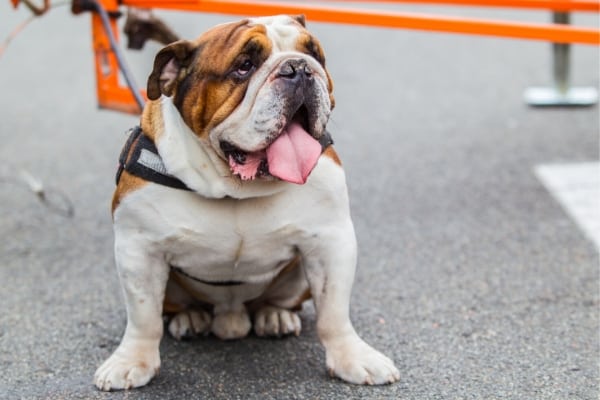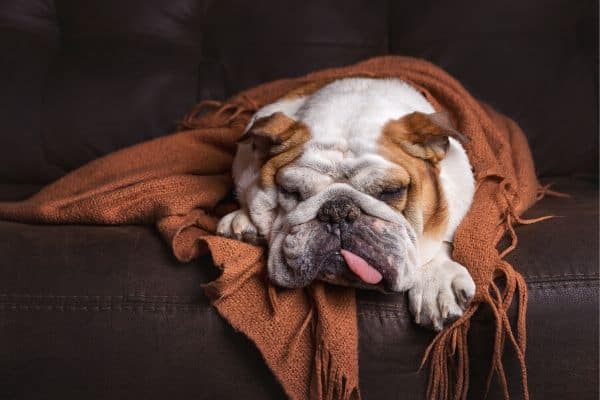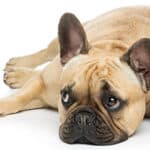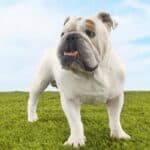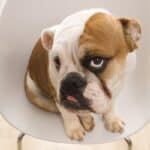Once used in the bloody, barbaric spectator sport of bull-baiting, the English Bulldog has come a long way. Today’s Bulldog, with its stocky, low-set build and wrinkled face, is now known for being exceptionally friendly, docile, and good with children.
If you’ve been considering getting an English Bulldog, you’re probably familiar with their courageous spirit, affectionate personality, and exceptional loyalty. It’s true that Bulldogs really are great family pets.
But what about shedding? Well, let’s take an honest look at what you can expect.
Do English Bulldogs Shed? Yes. All dogs shed to some extent. English Bulldogs will shed moderately all year, with two heavier seasonal shedding periods as well. Because they lack a thick undercoat, only single hairs are shed here and there, not clumps of fluffy fur.
So, English Bulldogs do shed. Now the question is how much shedding can you realistically expect.
Let’s look at what’s considered normal and discover common causes for excessive shedding. We’ll also give you some tips on how to decrease the amount of hair scattered throughout your home.
What Is Considered “Normal” Shedding for a Bulldog?
Life with an English Bulldog means finding short, single hairs sparsely covering his bed, your couch, your floors, and, yes, your clothes.
A few swipes with a lint roller will usually take care of the stray hairs on your clothing, but because of the stiff texture of Bulldog fur, hairs may cling a bit tenaciously to other fabrics such as upholstery and carpet.
So, should you expect to find some Bulldog hair laying around the house? Yes.
Should you expect mounds of fluff skittering across the floor whenever you walk through a room? No.
When Should You Be Concerned?
If any of the following are noticed, your Bulldog may be experiencing abnormal shedding due to an underlying condition and should be seen by a veterinarian.
- A massive increase in lost hair not caused by seasonal changes.
- Patches of missing fur.
- Dry, brittle coat.
- Shedding accompanied by extreme itchiness and/or flaking.
- Clouds of free-falling hair whenever your dog scratches.
- Thin, unhealthy coat.
- Skin irritations and/or open sores.
What You Can Expect
If you imagine enjoying a spotless house once you bring your new English Bulldog home, you’re setting yourself up for disappointment and frustration. It’s much better to embrace the fact that a bit of shedding is inevitable and is a small price to pay for owning such a delightful companion.
Year-Round Shedding
There’s no getting around the fact that Bulldogs shed. It’s the coat’s natural way of replenishing itself. A few hairs left behind whenever your dog gets up from a nap, hops down from your lap, walks from room to room, or is petted is part of normal, daily shedding.
Because of the Bulldog’s light-colored hair, shed hair tends to be more noticeable on dark fabric, and while they might stand out, the amount shed is actually far less than that of double-coated breeds.
Seasonal Shedding
Expect to see an increase in shedding as winter gives way to spring and again when fall approaches, though the fall shed will be much lighter. As seasons transition, your Bulldog’s coat will too to better equip him for the coming temperature changes.
Shedding of the Puppy Coat
Most dogs, Bulldogs included, are born with a finer, softer version of their breed’s typical coat. Between the ages of 6 – 10 months, the puppy coat will be shed as the adult coat grows in. The change is usually very gradual, but more shedding is to be expected during this time.
Possible Causes of Excessive Bulldog Shedding
There are many factors that can lead to excessive shedding. While the following causes are the most common, the list is not comprehensive, and a veterinary exam is always recommended if you suspect that your Bulldog’s shedding is abnormal.
Genetics
English Bulldogs inherit certain tendencies from their parents just like people do. If one or both of your Bulldog’s parents were heavy shedders, your dog may wind up shedding more than normal too. Before purchasing a Bulldog, speak with the breeder about the parents’ shedding tendencies, and only purchasing a dog from a reputable, knowledgeable breeder.
Diet
Skin sensitivities are not uncommon with English Bulldogs and are often triggered by ingredients commonly found in commercial kibble, such as corn, wheat, food coloring, and even proteins like beef or chicken.
Consult with your veterinarian for options in pinpointing the allergen(s) that are triggering the response in your Bulldog. He or she may recommend switching to an allergy-friendly kibble (this is a popular choice), perform skin and blood allergy tests, or suggest an elimination diet.
Environmental Allergies
Foods are not the only cause of allergic reactions resulting in itchy skin and excessive shedding. Dogs can also be allergic to triggers like pollen, dust, flea bites, mold, or grass.
While symptoms such as red, watery eyes or itchiness of the skin, eyes, ears, and paws are common with environmental allergies, patchy hair loss and/or increased shedding is often seen as well.
Parasites
External parasites like fleas, ticks, or mites cause extreme discomfort and itchiness in dogs, especially those with rather sensitive skin like Bulldogs. All of that extra scratching and chewing to relieve the itch can lead to excessive shedding.
Disease
Thyroid conditions; diseases of the liver, kidneys, or adrenal glands such as Addison’s disease; and autoimmune disorders can all cause an increase in shedding amounts.
Pregnancy/Lactation
Many Bulldog breeders claim that increased shedding is noted during pregnancy and while nursing. The reason for this is that the mother’s body becomes depleted of calcium and other vital nutrients while her body is focused on supporting the puppies. A special diet or supplements often corrects this issue quickly.
Stress
Shedding is a dog’s natural response to stress. You’ve probably seen this firsthand while petting your dog in the veterinarian’s waiting room. Whenever your dog is stressed, expect an increase in shedding.
5 Tips to Decrease the Amount of Shed Hair
Although there’s nothing that you can do to totally stop your English Bulldog from shedding (and that should definitely not be your goal anyway), there are a few tricks other Bulldog owners have found that help to reduce shed hair in their homes.
1. Brush Daily
Brushing is the easiest, most effective way to combat the mess. A quick once over with a soft bristle brush, rubber curry brush, or grooming glove daily will capture any loose hairs that would otherwise be shed. For even better results, finish up by running a damp cloth over his body to catch any hair that the brush missed.
2. Supplements
Adding foods rich in omega-3 fatty acids like fatty fish and flaxseed oil or providing a supplement like salmon oil has been known to improve excessive shedding in Bulldogs by nourishing the skin and the coat. This one is specifically formulated for dogs.
3. Baths
Regular baths will keep your Bulldog smelling and looking good, but they’ll also loosen dead hair that’s ready to be shed, especially if you use a deshedding shampoo and brush the coat thoroughly once it has completely dried.
4. Change Diet
Working with the advice of your vet of course, try switching your Bulldog to an all-natural, nutrient-rich food free of corn and wheat designed to improve the health of the skin and coat.
Dog’s hair consists mainly of protein, so to foster a healthy coat, be certain that his diet is high in protein.
5. Clothing
This tip may sound strange at first, but some owners say it truly helps. Try outfitting your Bulldog with a small T-shirt when he’s at home. As he goes about his daily routine, any shed hairs from his trunk will remain trapped inside the shirt and not scattered all over the house.
Related Question
Do English Bulldogs Drool?
Yes, some drool can be expected, particularly when food is anticipated and after drinking. Bulldogs have large, low-hanging flews (cheeks and upper lips) and lower jaws that stick out a bit in front.
While these features give him that classic, endearing “Bulldog” look, they also prevent the mouth from completely closing, and saliva escapes in stringy strands.

